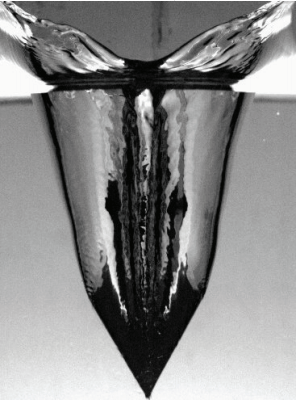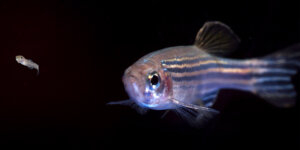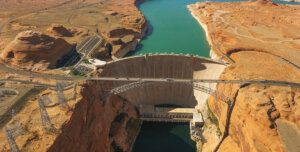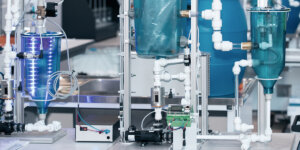
Brown pelican diving into the water. Photo/Sharp Photography
Relaxing by the Santa Barbara shore one sunny afternoon, Professor Eva Kanso marveled at how the surrounding seabirds dropped effortlessly out the sky and sailed into the water in a matter of seconds. But it wasn’t until she invited her colleague Sunghwan “Sunny” Jung to USC to give a talk on the mechanics of diving that she decided to investigate the phenomena for herself.
Working with her team from USC Viterbi’s Department of Aerospace and Mechanical Engineering (AME) Biodynamics Lab, Kanso began to evaluate the forces that occur during water entry. In collaboration with Jung, who is a Virginia Tech professor, and Stony Brook University Dean Fotis Sotiropoulos, with whom she shares a grant from the National Science Federation (NSF), their findings will be applied to engineering and bio-related systems, such as naval vehicles and platform divers, and will improve submerging techniques.

A plastic wedge entering the water. Photo/Biodynamics Lab
“We performed a very detailed study of the impact forces on a wedge that enters water. We were inspired by these birds,” said Kanso, Zohrab A. Kaprielian Fellow in Engineering. “Sunny was mostly interested in the biodynamics of the neck because, if you think about it, they’re diving at such high speeds and the most vulnerable part of the body is the neck.”
For instance, the Cape gannet, a large seabird from South Africa, enters the water at speeds of 60 miles per hour, reaching depths up to 40 feet to capture its prey. Wanting to know how they are able to sustain such an impact, Kanso decided to start at the head of the problem, or in this case, the beak.
Using 3-D printed plastic wedges, they examined how the angle of the beak affects the impact force as it hits the surface of the water. They found that by changing just this angle, they were able to minimize impact.
“If a flat plate is thrown into water broadside on, that’s very harsh, there is a big impact force. As you turn the plate into a wedge and start decreasing its angle, then you start decreasing the impact force,” Kanso said. “But there is a transition from really impactful entry to kind of smooth entry where you don’t see almost any rise in the impact force.”
This transition was found on wedges with a 70-degree angle. Any larger and the forces quickly increase, while smaller, sharper angles saw almost no change in force.
The team also studied the details of the splash itself, particularly how it evolves and what forces play a role in creating it. In addition to the initial impact force that causes water to shoot up around the object, Lionel Vincent, a post-doctoral scholar in Kanso’s lab, discovered an additional suction force created by a vacuum within the cavity of the splash, pulling the water back down. It is this force that they found to be responsible for the splash shape.
“As the wedge goes inside the water, you see the little splash and you see this interesting part that is going downwards instead of being expelled upwards like the rest of the water,” Vincent said. “You have to fill this pocket of air and the way to fill it is to suck air in from the far side, causing the pressure there to decrease and the water to be sucked down.”
By nature, splashes are very complicated. But there are very few computational models that ignore all of the complexities of the real world and focus solely on the fundamental forces that act on the splash. For their study, Vincent created one of the first such low order models, breaking down the splash into individual water particles that shoot from the surface.
“Each one of those particles will be subject to both aerodynamic forces and gravity, as well as this additional suction force that one wouldn’t have thought is an important ingredient in the dynamics of the splash,” Kanso said.
The team is continuing their investigation of splash dynamics and, with Sotiropoulos’ development of more robust computational models for fluid-solid interactions, they plan to find ways to minimize splash.
“That’s our next step – to try to look at how you would manipulate the shape of the splash by changing your shape under water immediately as you enter,” Kanso said.
Similar to how Olympic divers open their hands underwater in an effort to minimize their splash, Kanso believes that creating a cavity under the water as you enter may pull the splash back in. In addition to diving scores, their findings could improve inconspicuous robotic vehicles used for military defense that travel from the air to the water.
Kanso and her collaborators will be discussing their findings during the American Physical Society (APS) Division of Fluid Dynamics meeting, held in Denver from November 19-21, at a mini-symposia titled “Diving Birds and Flying Fish,” organized by Kanso and Professor Alexandra Techet of Massachusetts Institute of Technology.
Published on November 15th, 2017
Last updated on February 9th, 2021











